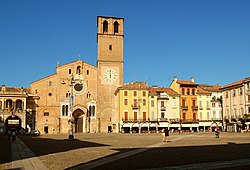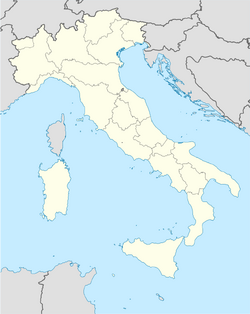| Lodi | |||
|---|---|---|---|
| — Comune — | |||
| Comune di Lodi | |||
| Piazza della Vittoria | |||
|
|||
| Coordinates: Coordinates: | |||
| Country | Italy | ||
| Region | Lombardy | ||
| Province | Lodi (LO) | ||
| Frazioni | Fontana, Olmo, Riolo, San Grato | ||
| Government | |||
| • Mayor | Lorenzo Guerini (Democratic Party) | ||
| Area | |||
| • Total | 41 km2 (16 sq mi) | ||
| Elevation | 87 m (285 ft) | ||
| Population (2008)[1] | |||
| • Total | 43,488 | ||
| • Density | 1,100/km2 (2,700/sq mi) | ||
| Demonym | Lodigiani or Laudensi | ||
| Time zone | CET (UTC+1) | ||
| • Summer (DST) | CEST (UTC+2) | ||
| Postal code | 26900 | ||
| Dialing code | 0371 | ||
| Patron saint | St. Bassianus | ||
| Saint day | January 19 | ||
| Website | Official website | ||
Lodi (Italian: [ˈlɔːdi] ( listen), Lombard: Lòd) is a city and comune in Lombardy, northern Italy, on the right bank of the River Adda. It is the capital of the province of Lodi.
History[]
Monument to Frederick Barbarossa.

The Battle of Lodi, by Louis-François, Baron Lejeune.
Lodi was a Celtic village; in Roman times it was called in Latin Laus Pompeia (probably in honor of the consul Gnaeus Pompeius Strabo) and was known also because its position allowed many Gauls of Gallia Cisalpina to obtain Roman citizenship. It was in an important position where a vital Roman road crossed the River Adda.
Lodi became the see of a diocese in the 3rd century and its first bishop, Saint Bassianus (San Bassiano) is the patron saint of the town.
A free commune around 1000, it fiercely resisted the Milanese, who destroyed it in 1111. The old town corresponds to the modern Lodi Vecchio. Frederick Barbarossa rebuilt it on its current location in 1158.
Starting from 1220, the Lodigiani (inhabitants of Lodi) spent some decades in realizing an important work of hydraulic engineering: a system of miles and miles of artificial rivers and channels (called Consorzio di Muzza) was created in order to give water to the countryside, turning some arid areas into one of the (still now) most important agricultural areas of the region.
Starting from the 14th century Lodi was ruled by the Visconti family, who built a castle here. In 1423, the antipope John XXIII launched the bull by which he convened the Council of Constance from the Duomo of Lodi. The council would mark the end of the Great Schism.
In 1454 representatives from all the regional states of Italy met in Lodi to sign the treaty known as the peace of Lodi, by which they intended to work in the direction of Italian unification, but this peace lasted only 40 years.
The town was then ruled by the Sforza family, France, Spain, Austria. In 1786 it became the eponymous capital of a province that between 1815 and 1859 would have included Crema.
On 10 May 1796, in the first major battle of his career as a general, the young Napoleon Bonaparte defeated the Austrians in the Battle of Lodi. In the second half of the 19th century, Lodi begun to expand outside the city walls, boosted by economic expansion and the construction of a network of railway lines that followed the reunification of Italy.
Main sights[]

Church of the Beata Vergine Incoronata (view of the interior),
- Piazza della Vittoria, listed by the Italian Touring Club among the Most Beautiful Squares in Italy.[2] Featuring porticoes on all its four sides, it includes the Basilica della Vergine Assunta and the Broletto (Town Hall).
- Piazza Broletto, with a Verona marble baptismal font dating to the 14th century.
- Church of the Beata Vergine Incoronata, considered one of the masterworks of the Lombard Renaissance.
- Church of San Francesco, built in 1280-1307.
- Church of San Lorenzo. It has a nave and two aisles, with frescoes by Callisto Piazza.
- Church of Santa Maria Maddalena, the best example of Baroque architecture in the city. The original Romanesque structure dated to 1162, but was remade in the early 18th century. The interior is on a single nave with side chapels, featuring, among the several artworks, frescoes by Carlo Innocenzo Carloni and a Deposition attributed to Robert De Longe.
- Church of Sant'Agnese, in Lombard Gothic style (14th cneutry). It includes the Galliani Polyptych by Alberto Piazza (1520), and has, on the façade, a rose window decorated with polychrome majolica.
- Church of San Filippo Neri, in Roccoco style.
- Palazzo Vescovile (Bishopric Palace), of medieval origin but rebuilt in the 18th century.
- Church of San Cristoforo, designed by Pellegrino Tibaldi.
- Visconti Castle (Torrione), a medieval castle now partially destroyed.
- Palazzo Mozzanica (15th century)
Economy[]
In 1864 Tiziano Zalli founded the Banca Popolare di Lodi, the first Italian cooperative bank (now part of Banco Popolare group).
In 1945, the Italian petrol company Agip, directed by Enrico Mattei, started extracting methane from its fields, and Lodi was the first Italian town with a regular domestic gas service.
Twin cities[]
 Constance, Germany
Constance, GermanyLodi, United States
Omegna, Italy.
 Fontainebleau, France.
Fontainebleau, France.
References[]
- ^ source ISTAT - Italian Institute of Statistics
- ^ - (2004). Piazze d'Italia. Milan: Touring Club Italiano. ISBN 8836534988.
- Agnelli, Giovanni (1917). Lodi ed il suo territorio nella storia, nella geografia e nell'arte. Lodi.
- Bassi, Agenore (1977). Storia di Lodi. Lodi: Edizioni Lodigraf. ISBN 8871210182.
Template:Province of Lodi
| This page uses content from the English language Wikipedia. The original content was at Lodi, Lombardy. The list of authors can be seen in the page history. As with this Familypedia wiki, the content of Wikipedia is available under the Creative Commons License. |



